There are a lot of great survival food products out there. At the same time, there are many survival foods that are simply not worth buying.
Before you buy survival food online or at the store, it may surprise you to learn that you can make the same thing at home for just a fraction of the cost. When you buy prepackaged MREs from some big camping company, it’s doubtful that you’re only paying for the food inside.
There’s a good chance you’re also paying for things like packaging, manufacturing, shipping, tax, and retail overhead costs. The actual food part of the MRE is more than likely something you could throw together by yourself for much less.
When you make your own MREs and survival foods, you’re in control of the choice and quality of ingredients, packaging, and storage. This cuts out all the middlemen between you and your MREs and gives you a better idea of shelf life.
Related: 3 MREs Recipes You Can Make At Home
In other words, you know it’s safe and it hasn’t been sitting in a hot warehouse or stockroom for months or years. This way, you won’t get any nasty surprises when you’re ready to eat your MRE survival food!
Here are just a few expensive survival foods that you can make a more affordable version of at home.
1. Freeze-Dried And Dehydrated Foods
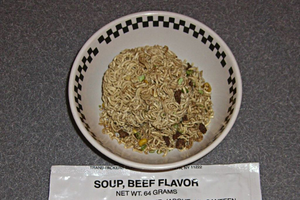 The most popular MREs are usually freeze-dried or dehydrated soups, stews, and one-pan meals.
The most popular MREs are usually freeze-dried or dehydrated soups, stews, and one-pan meals.
For premium survival food meals like this, you can expect to pay close to $80-$300 for around 10 single-serving meals – or between $10-30 per bowl. Now, that’s some expensive soup!
With that level of investment, you could build those same MREs with cash to spare. Or, better yet, you could buy enough food to freeze-dry or dehydrate your own meals for several months, at least.
Related: 50 Foods to Dehydrate for Your Stockpile
Dehydrating or drying your own food is easy. You can use a home freeze dryer or food dehydrator if you have one. Still, there are more than a few ways to dry and dehydrate your food without counting on electricity, like using the sun and wind.
Additionally, buying already freeze-dried foods by themselves – such as fruit, jerky, grains, or vegetables – is usually more economical. This is especially true if you don’t specifically seek out foods marketed as survival items.
When you make your own freeze-dried or dehydrated MRE soups and stews, you end up paying less for a heartier and healthier meal. Here is an MRE recipes that you can make at home using freeze-dried and dehydrated ingredients.
Beef stew:
Ingredients:
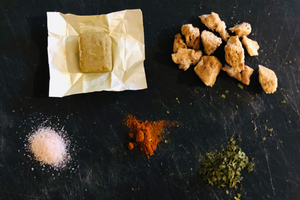 ¼ cup dried vegetables such as carrot, peas, tomatoes, potatoes, or onions
¼ cup dried vegetables such as carrot, peas, tomatoes, potatoes, or onions- 2 tablespoons of dried meat, like jerky or pemmican, cut into small pieces
- salt, pepper, onion powder, garlic powder, and any other spices
- beef bouillon cube
Instructions:
- Seal ingredients in a mylar pouch or vacuum-sealed bag with oxygen absorbers.
- For cooking, remove oxygen absorbers and add hot water to the bag. Close the bag and allow your MRE to cook to desired texture before eating.
Depending on your choice of ingredients, this recipe costs around $3-5 per prepared MRE.
2. Survival Bars
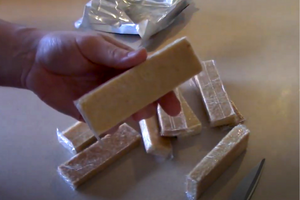 When looking at the ingredients for popular survival bars, the contents don’t always reflect the cost.
When looking at the ingredients for popular survival bars, the contents don’t always reflect the cost.
At their most basic level, most bars are made with the same ingredients: enriched wheat flour or enriched all-purpose flour, sugar, some kind of oil and of course, preservatives.
When you make your own survival bars, you get to customize the ingredients and storage methods so you know exactly how long they should last and how they were made.
Before making your own survival bars, it’s important to note that the biggest threat to the shelf life is exposure to moisture.
Too much moisture can encourage bacteria and molds to grow that can ruin your bars in a matter of days if not refrigerated.
⇒ How To Make Survival Bars At Home And Add Them To Your Stockpile
To keep your bars in good shape for several months at room temperature, it’s important to dehydrate or dry your bars out as much as possible before packaging.
Aim to use ingredients that have a lower moisture content to help extend the life of your survival bars.
Classic Peanut Butter And Oatmeal Bar
Ingredients:
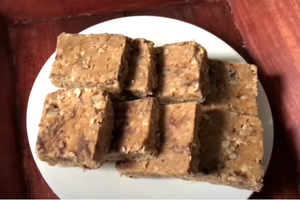 2 cups old-fashioned oats
2 cups old-fashioned oats- 1 cup low-fat peanut butter powder
- 1 cup of sugar
- 3-4 tablespoons of honey
- 1 teaspoon vanilla extract
- ½ teaspoon salt
- 3 tablespoons of water
- 1 cup dehydrated low-fat milk powder – you can sub milk powder for dairy-free milk powder if needed
- 1 3-oz. package of plain or flavored gelatin mix, unprepared (for texture and flavor)
Instructions:
- Preheat your oven to 200 degrees Fahrenheit
- Combine all dry ingredients until everything is incorporated and set aside.
- Add gelatin, water, and honey to a saucepan on medium to medium-low. Stir often until the mixture comes to a boil, then remove from heat and stir for 1 minute. Allow mixture to cool slightly.
- Combine dry and wet ingredients into a bowl and combine until the mixture holds together.
- Line your baking dish with foil or parchment paper. Then, press the cooled oat bar mix down onto the dish with a flat-bottomed measuring cup or wooden spoon until it forms an even layer.
- Place your pre-sliced bars in your preheated oven or solar dehydrator for around 2 hours – your bars should be very dry and hard when they’re finished.
- Remove from the oven and allow to cool. Store a bar or two in an airtight container, mylar bag, or vacuum-sealed bag, with oxygen-absorbing packets.
Depending on your choice of ingredients, this recipe costs around $10 per dozen oatmeal peanut butter bars.
3. Survival Food Buckets
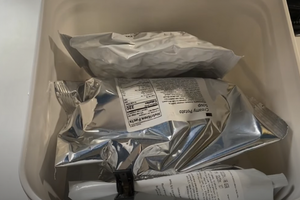 I don’t know if there is a better example of overpriced MREs in the survival food industry than the emergency food bucket market.
I don’t know if there is a better example of overpriced MREs in the survival food industry than the emergency food bucket market.
More than this, some of these survival meal kits are filled with low-quality, repetitive meals that are incredibly overpriced.
On the lower end, you can buy these kits for around $200. On the higher end, expect to pay thousands of dollars.
Related: What Really Happens if You Eat a Bucket of Survival Food When SHTF
Basically, these food bucket kits seem like a good idea at first – until you start asking questions. How long have these expensive survival kits been sitting?
Where and with what were they made? Will the food inside be edible enough when you really need it?
When you build your own survival food bucket, you don’t have to worry about those things.
The best part is that you can build your own survival food kit for around $20. All you need is a 5-gallon bucket and some homemade MREs to store enough food to feed one person for a month.
Your bucket can be very simple, or you can get creative and add more variety to your meals. Here’s one idea for a 5-gallon DIY survival food kit bucket:
5-Gallon DIY Survival Food Bucket:
Ingredients:
- 1 lb. dried beans of your choice or mixed variety
- 1 lb. white rice
- sealed packages of salt, pepper, sugar, bouillon, or other spices
- DIY dehydrated/ freeze-dried MREs like soup or one-pan MRE above
- DIY hardtack survival bars
Instructions:
Pack bagged and sealed MREs tightly in a 5-gallon bucket along with oxygen absorbers. Keep in a cool, dry place away from sunlight if possible. Eat within the appropriate timeframe for your selected foods.
Long-lasting survival foods like freeze-dried MREs, survival food bars, and other emergency supplies are great to have in your SHTF stockpile.
But, before you go out and buy those expensive survival foods, take a look at the cost of ingredients compared to the sticker price. You might be surprised at how much money you can save by making these long-lasting foods in your own kitchen.

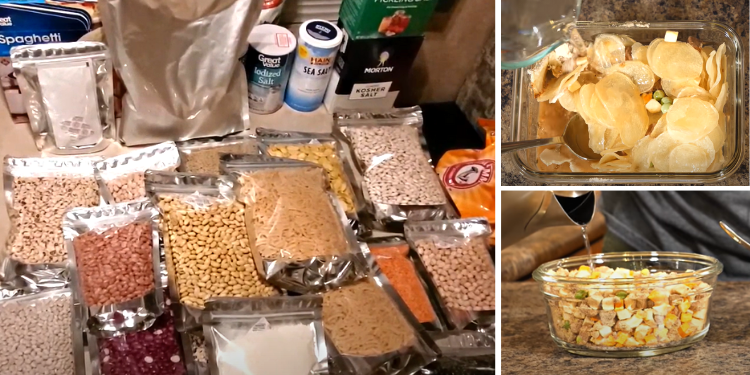




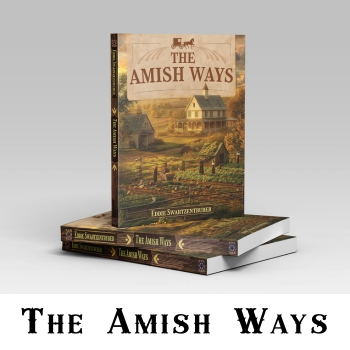

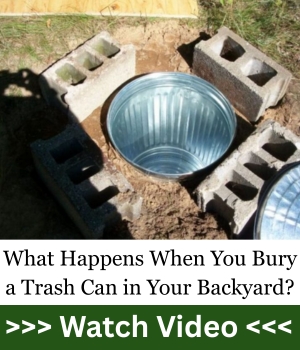






If i would go back a few years i would recommend to myself to buy a freeze dyer and just make my own food.
MRE are not exactly what i would want to “live off of” and you shouldn’t….. You can tell which people never had to eat them vs those who sample them. After 3 days of eatting two MRE a day and you might never shit but…Eventually when you do…. You should be picking out a name for the birth of your child
Crude comment but correct, MRE’s were designed to be low fiber high calorie foods for combat situations. Military doctrine is MRE’s for movement to contact with the enemy, real foods are fed at base camps as to prevent the constipation mentioned above.
Unless you’re on the move I suggest basic dry goods from Walmart. Most canned and dry foods need little more than a cool, dry, pest free dark place to last two years plus. Price per calorie difference is amazing.
After Walmart’s are smoking debris a more modern version of the 1800’s comes into play IF your prepared and skilled. Solar dehydration can be as simple as window screens (cleaned up) holding sliced or chopped up foods in an abandoned car with some windows slightly open.
How dry? Dry until crisp, no bend just snaps. Been done even as far back as the Roman times and earlier.
Better prepared build solar dehydrators and have stainless steel screens and silicone drying mats for better performance.
In both cases then you need some pest proof and moisture proof containers to keep that dehydrated food dry and safe. Recycled clean jars work well. I personally love wide mouth peanut butter plastic jars.
You can even pre-mix soup-stew mixes for a dump into a pot and add water cooking.
Expect some home dehydrated foods not to be as nice as expected. Rotation and inspection can allow you to eat most of it with enjoyment, some will go to chickens or compost. My Grandmother used to open her own chicken eggs one by one into an “egg cup” to make sure they were good before adding to the rest of the meal.
One bad egg would make all the rest nasty.
Michael: Same, good post. niio
I believe that, in order to not go insane, you should have a very large stockpile of food of some kind. In many different varieties and forms. Think long term always. We do not know how long this will go on.
Proverbs 3:10
PS: maybe stock up on some kind of stool softener. For those MRE’s…
Lots of natural softeners at health food stores. Senna, cascara sagrada, just two off top of my head.
Great idea and I am going to add some.
chew the gum….. in theory
Curiosity question. Is it possible, or even wise, to “pre-load” your MRE with something like Miralax? It adds no extra flavor, so the taste should be relatively the same, but would the heat destroy the effectiveness of the softener?
Hilarious!! I get DOWN voted for asking a legitimate question?? Just goes to show the people visiting this website don’t have a clue about civility. Instead of down-voting my question, why not give a response to why it is a bad question.
Pepper in training:
Difficult to respond to you because
there is no “Reply” tab near your comments!
I went up to reply to “red ant” – & hope you will see this notation!
With daily, organic, very high fiber, grains :
Garbanzo beans / chickpeas (WHICH ROMAN SOLDIERS ATE!)
and
Lentils
There is no problem with regularity.
The Human adult body needs 20-30 grams fiber daily ….and water!!
Prepper: Garbanzo beans are a very good late winter crop in AZ. They like the same weather as green peas. If you have prickly pear, and every lower 48 states have a native, pads will ‘relax’ you into a nasty hell unless cooked. We stockpile mesquite, which is high in fiber and a high energy food. niio
Meg: LOL! Definitely. niio
MREs are a lot better now than when they first came out. We used the crackers to hammer nails into 2x4s they were so hard, needed to soak them in water overnight to be able to eat them, had one guy in our platoon that broke a tooth trying go eat one straight out of the pack. Dehydrated beef patties were like cardboard and don’t ask about some of the other stuff, we lived off of the peanut butter and cheese spread while in the field.
MREs are made by Sopakco here in (Mullins/Bennettsville) SC. I’ve toured their facility. They take great pride in what they do. Also, I was still active duty, stationed at Bragg and a member of the 82nd when we transitioned from C-Rats to MREs under Reagan. About the same time we transition from steel pots to kevlars, jungle cammies to BDUs, 1911s to M9 Berettas, jungle boots and combat boots to these Gortex brown boot things …. M16A1s to A2s … a lot of transitions back then and I can tell you that the MREs were a welcome change from C-Rats at the time. Now, I missed the Dead Duke Disk round toffee bars in C-Rats and the canned peaches and the canned pound cake and the turkey rolls … but, for the most part the MREs were an upgrade. Crazy thing was that when I did my first tour with the 509th Airborne Combat Team in Vicenza, Italy (where I got my nickname) I actually hat to transition back to C-Rats for awhile. They were about a year behind us at Bragg in terms of field chow.
I loved C rats! Chopped ham and eggs were the best. I used to gain 5 pounds in the field from all the un-wanted h/e given to me by my platoon. Other great items: hot chocolate, pound cake, john wayne bars, canned peaches, and cigarettes, etc. So many memories.
Gallo: C-rations and MREs are still fresh, at least according to the government. If you can, stock mesquite beans. They still ‘fresh’ even after 40 years. Fresh to a scientists is the seeds will sprout when stored right (place in burlap sack, throw on a shelf and forget them for a few decades LOL). They need to be kept 6 months before grinciong and the beans (35% protein) have to be crushed before cooking. niio amico
Buon Giorno Gallo Pazzesco! We used to chat over at marlinowners a few years back (Pat/Rick). Good to hear from you again.
When I was in the Marine Corps, I always tried to trade for MRE dehydrated beef and pork patties. I TOOK 5-6 packs of beef Ramen noodles. I broke the patties into pieces and mixed them with the Ramen noodles in my canteen cup and heated over a fire or those heating tablets. With the crackers and other food in the MRE , it made for a decent meal in the field. I also packed dried apricots, apple slices and some cans of sardines and tuna. I was a TOW gunner so weight wasn’t a problem as we were in vehicles.
Good stuff Christine. These sort of pieces are helpful, informative and educational. Much appreciated!
Freeze drying and dehydrating are good options if you know you will have access to potable water and a reliable heat source such as a wood burning stove and plenty of firewood. That said, canning wet foods which can be consumed right out of the jar is a better option if your access to potable water is limited. You will want to use the water you have for hydration.
Other than pickled foods packed in vinegar or canned fruits packed with lots of sugar, all wet, canned goods should be boiled before being consumed, to avoid botulism and other nasties. This is especially true of low-acid foods like beans and potatoes but even tomatoes, a high-acid fruit/veggie, should be cooked thoroughly before eating. This is true for commercially canned goods as well as home canned goods.
I pretty much add citric acid to everything I can these days just to be sure, pressure can at 11 pounds, 240F. Try to eat home canned within 1 year, have eaten 2 year old home canned by me food with no problem, find 5 year old jars back in the pantry from time to time with intact seals but throw them out. Would definitely cook canned meat well before eating. Have to say, in younger poorer days, I ate many a can of Chef Boyardee etc… w/o heating it Cut the can open with my knife, pour contents into mouth, wash down with PBR.
What is the source of your advice? It is incorrect data.
Commercially canned foods is just that: canned- as in high heat, boiled! That is what canning is.
Your advice seems weird to on low acid wet foods since Boiling alone of low acid foods without high pressure will not kill botulinum spores nor its toxins that can kill us. That is exactly why Pressure Canners exist.
How long does canned foods with liquid last?
depends on how you store it….Cool dark temps…. long time… keep it in your car over summer not very long.
canned goods best not after two (2) years?
keep them in a darker place/ cabinet. ..with regulated temperature
(Avoid heat/sunlight)
Also best to discard dented cans…lest somehow air got in?
rm p
Can goods, can last far past there due date.
I have wolf brand chili. That is 8 yrs. past its due date. still good, but very well tookin care of. Your can goods, can last a very long time.
Can Tomatoes and Fruit, do not last long only about a yr. after that, they get a very heavy metallic taste.
Do some test on how long you think can goods, can last.
Dig back in your supply and do some test on your prep.
Let us know, if good or not.
4Patriots food which this site advertises is the probably the worst you can buy
“4 Patriots & Patriot Power both…AND ” WISE”….
I spent more money on them than I wish I had, for sure….?
They are over priced as well ?
However, their “Patriot Greens” powder is good to
ADD to fruit juice and water?
But BUY ON SALE ONLY!!! ?WAIT FOR THEIR PROMOTIONS ??
Thank you so much for confirming exactly what I have been saying on this site repeatedly!!! The For Patriots food is very dangerous, with so much ROUND-UP on the types of conventional foods they use. You could die of CANCER in short order eating those foods. A home freeze-drier is worth every cent. Check Craigslist if you need to reduce costs. I love mine, and though it was somewhat of a struggle to buy it, I have used it often ever since. That means between my pressure-canner for canning meats, etc., I will be pretty set to share with the poor when SHTF! Proverbs 19:17- “Whoever is kind to the poor lends to the LORD, and He will reward them for what they have done.”
Now, that’s a bible verse you can take to the bank!!
Don’t forget to rely on God’s word when you are in trouble or even if you are not. You are guaranteed to be blessed by it!!
yup, high in carbs and not much else.
read the labels, know what you are buying.
two things rarely mentioned that we keep stocked for long term is Ovaltine for a little vitamin supplement that makes the powered milk taste a whole lot better and can also be mixed with just hot water for some “hot chocolate drink”, and also unflavored water-soluble fiber powder that can be added to just about anything – we add a spoonful to the morning cup of coffee and don’t even notice it.
I disagree with Christine. Yeah, the companies that make the MREs and freeze dried meals aren’t in it to save lives, they’re in it to make money. Let’s see any of you do the same thing and not try to make anything off of it. You wouldn’t do it. You’d want compensated for costs and labor. In this case they provide a valuable resource for those that do not/cannot have the resources or ability to make their own meals. I know a woman that has a freeze drier, and it is by no means easy or cheap to run. Unless you are doing it in bulk, it can be cost comparable to buying it ready made.
I have a duffle bag full of Peak & Mountain House food. It is an investment. A packet that costs me $10 now may be pricey, but in a crisis, what would I, or you for that matter, be willing to pay in the event that you, or I, have nothing else? No matter how prepared and skilled you may be, there is always the chance you might have nothing and may have to fall back on one of those meals. Go ahead and make your own if you want. What is the shelf life of a homemade meal versus one of Mountain Houses meals? The art of survival means that sometimes you may have to include the fancy stuff in your pack. Just the way it is.
I know this to be 100% gospel. Been there, done that, likely will again someday.
Christine, thanks for the article. I strongly dislike stumbling over those goofy survival foods ads. I can go to food for living and get all the ingredients (but meat) for less than that, and know it’s organically grown.
Old-time recipes from pre-colonial era:
Dehydrated ham soup here is,
1 gallon dehydrated refried beans
1 quart dehydrated ham or other dried smoked meat. (Chopped jerky is real good in this.)
Onion and garlic powder to taste
1 cup dried roasted chilis
Several ounces of dried starch noodles (made mixing food grade starch with water to make dough, cut and drop in boiling water, will turn glassy looking for those ‘invisible’ noodles the little kids giggle over).
To cook, just add enough boiling water to make it a soup, cover for ten minutes and serve. Ham if going to be chewy and may need to ‘rest’ longer, but we all have good teeth !
Optional, 3 parts cornmeal or cornflour, 1 parch starch to make dough, cook needles, dry and all they need is boiling water to rehydrate. Add butter and black pepper, or just rehydrate in simmering milk for noodle soup.
niio
This sounds delicious! Thank you for keeping this treasure alive by sharing with us. I’m going to save it and try it very soon. 🙂
I lived in Italy in 1960’s, we had a bad flood, cut off from everyone else. Dad was in Army so we C rations, we lived off those for three weeks. I liked them.
Go to the 1990’s, my son wanted everything military, would only eat MRE’s for dinner. Made my life easier! Even today we eat MRE’s for kicks. Keeps our taste buds ready for whatever happens.
I do have food from one of the companies out there that was expensive, I find that food is very good compared to others, I eat it on a regular basis to keep other food costs down.
During pandemic when our grocery shelves were empty, my dad (age 93) panicked saying we were going to go hungry, I’m like “no we’re not as we have plenty of food downstairs to last for a long while.” That was so comforting to me. We used it too.
Some useful information, however, I would note that MREs (“Meals-Ready-to Eat”) were designed to be consumed for limited periods of time in the field with little-to-no prep required (yes, I know soldiers use tricks to make them more palatable, but that was the concept). I would not put freeze-dried or dehydrated foods that require water and preparation in the same category. I would be interested in seeing recipes and packaging techniques for true homemade MRE substitutes.
Well hell, why don’t we all run out and drop 3 grand on a freeze dryer. MREs are not designed to live on but the calories are there if needed which is better than most companies can provide for there “survival food”. Those products are just dragging out starvation. Before anyone says you haven’t had to use MREs for a few days stop right there. You have no idea of what I’ve done so don’t assume you do. There are too many companies selling junk that just don’t hold up but most people get this “survival gear” and they think there ready for whatever comes with it still in the original packaging stuck in a closet. I bought a particular item from 4patriots and during testing it fell apart like a 2 dollar watch and there dehydrated foods are terrible with low calories. Mountain house, your no better. Anyway MREs will get you through which is what there intention is, not to thrive one because you definitely won’t. Prepping isn’t a casual hobby. if it’s not done right and with all the seriousness you can muster then you won’t make it on you own. Not to worry though, you can always rely on the government. HAHA
sorry joe seems like you can’t draw the difference in a general statement. Let me guess former Special forces … kicked doors and served chow on time in the mess DFAC.
Anyways go rant over nothing. Prepping if isn’t a homestead deal is just a slow death.
Prepper X-spurt, you sound just like that bogus ex-Army reject that is so stupid that in a real SHTF situation he is very likely to get himself and those around him killed by his arrogant ignorance.
Apparently there is a slight issue with you understanding a statement. You may want to address those short comings soon and not make those mistakes to often.
I was active duty for 20 years and sometimes ate the real Military Issue (with NSN’s) MRE’s, both single meal and the “camp” versions designed to feed groups of people, and they are better than going hungry but definitely not what I want for long term subsistence. The author of this article does not seem to know the difference between real MRE’s and freeze-dried / dehydrated foods, so I would surmise the author has no real-world experience with real Military Issue MRE’s.
Folks, please do you own research and decide what is best for you. I am a firm believer in “practical prepping” which in previous times was just common-sense planning ahead for things that could go wrong.
Joseph, I agree with not overspending on your preps. If someone can afford the higher end equipment then that’s their choice, but I do not recommend anyone to invest more than they can really afford, and I will never fault anyone for living within their means. For those that have the true desire for practical prepping, they will save and then purchase, as most of our generations before us did, but for those that decide their “entertainment” is more important, and that includes the restaurant food and coffee-shop lattes, then they may wish they had made other choices what they spent their money on if they get hit with a SHTF situation, most likely a natural disaster like flooding, fire, earthquake, storms, etc.
Or instead, as some of the narrow minded have proclaimed, we should all go buy a remote “bug-out” location and drop everything else in our lives and move there immediately, or even worse, go into debt for several hundred thousand we can’t afford to have bunkers built for “just in case” there is a nuclear holocaust.
As I always profess, Practical Prepping is what I believe in, and recommend for people to do what they can within their means to prepare themselves in case they encounter hardships. Practical Prepping is just another form of “insurance”, but in knowledge and supplies obtained before the crisis, in addition to having a “promise to pay” document from some Insurance Company that you will have to file a claim for after the fact.
tim is posting another SPAM sales pitch link without telling you what the link is really for – looks like a SPAMMER-SCAMMER to me
So annoying the author calls MREs dehydrated and freeze dried, all interchangeably. They are not. At all. Not even close.
Winter mre have freeze dried food.. it’s mountain house but they are slightly better.
I agree with the author’s theme that most people can do better building their own meals and putting them away for hard times. I do, but I will admit to having a mix, some Mountain House, some Augason Farms, several weeks of canned goods especially meats, and the old standard of rice, beans, wheat(and grinder), corn, oats, barley. My current activity is concentrated on exactly what Christine is suggesting. I usually make a stew, soup, bean pot of some kind, or whatever and freeze dry the leftovers. I then package them in two to three serving amounts for a just add water meal. I freeze dry roma tomatoes (skinned and quartered) but I also keep Augason tomato powder. I don’t think I can make my own as cheap as theirs. Most of what I have put away is based on sheltering inplace, but the mountain House could be used for several days on the road if we had to leave home.
Regarding Sandys question about how long to trust canned goods. I was eating 1952 canned C-rations in 1969. Almost 20 year old food, been there done that. In the high heat and being on the move, turkey loaf was my favorite lunch.
The take away from this article should be do as much for yourself as you can. The more you pay someone else to do things for you the less independent and the more vulnerable you are.
Please keep me informed on further information on your website.
Folks should also consider adding ghee, coconut oil, and other fats to their survival stash. The human body is designed to use fat for energy, body heat, hormone creation, brain development and so on and fats should form a large part of a persons diet. Do not use vegetable oils as they can overload the body with excessive omega 6 and cause health problems by throwing out the balance of omega 3, 6 and 9 in the body.
Coconut oil is also anti-viral, anti-bacterial and has many other health benefits.
Ghee and coconut oil can keep for many years. I use them as sandwich spreads and add them to most meals. I try not to destroy these fats with cooking, and choose organic if I can.
Also, whereas sugars and carbs can make a person feel hungry soon after a meal, fats tend satiate a persons hunger. After a meal with quality fats and person continues to feel satisfied for many hours after. No feelings of hunger.
A group of U.S. Marines were surveyed. They were asked “WHAT ARE THE THREE WORST FOOD ITEMS YOU’VE HAD TO EAT?” They answered: 1) MRE’s. 2) CHIPPED BEEF ON TOAST. 3) SPAM/
C-rats lima beans & ham was pretty gross. But I loved SOS… enough that I still home-brew it in my own kitchen regularly. Hard to beat. Then again I have chased sardines with donuts and chocolate milk.